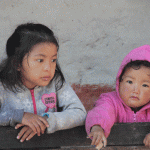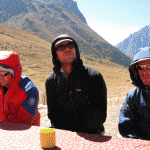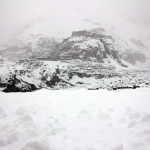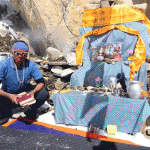I struggled to cram the last big of kit into my huge bag. It wasn’t anything technical like crampons or ice screws, or vital like my first aid kit or medication, but that half bottle of Talisker I was determined to take into the mountains. Eventually it slipped in, but I though to myself ‘after all these years, why do I still take so much stuff..?’ I was sure I’d got too much gear, but knew that Himlung was notorious for its cold weather.
I dragged myself onto the train, and after a mammoth carry across St Pancras, I tubed into Heathrow and checked onto the flight. With an age to spare before my departure, I tucked myself into a corner and gazed across the world of Duty Free. I’ve always found airports fascinating places, full of laughter, tears, peace and chaos. People walk like overburdened ghosts in large marble halls, as others sell the detritus of travel. I just sit and watch the literal world go by.
I do love a good conversation. I suppose being a speaker doesn’t help, but so many times when I travel, I find people are plugged into their digital life support and they won’t even make eye contact, never mind open their mouths. Thankfully I was seated with a couple of British Indians from Derby, and we passed the waking hours with ease. Conversations ran from watching the Rams, to the quality of samosas, and It was a pleasure to both meet and travel with them.
After a few hours in Delhi, I flew onto Kathmandu, where the skies were Crimson as the sun set. Rain had fallen, and the air was fresh and cool.
I caught up with my old climbing friends Jamie and Clare Glazebrook in the Hotel Tibet. They had flown out the day before and already looked like the excellent travellers they were. I had delayed my journey due to a family wedding, but it made little difference. We had known each other years and were soon chattering away about news of ascents and avalanches. We spent the evening in Tamil, catching up and eating under the bright moonlight. The stresses of my professional life were already falling away, and I could feel the constant pressure that I had suffered behind my eyes dissolving. Good company, adventure and excitement were with me in huge quantities.
The next day we met Christian and Nikolai and the team was complete. Both of them were climbers who lived in the Dolomites. It is one of my favourite mountain ranges in the world, and is famous for breeding strong mountain men. From our first words of introduction I knew that we were going to be a fantastic team.
We left The city, bound for Besisahar on a small bus, which battled through chaotic traffic, navigated potholes and did its best not to run any passing pedestrians over – so is the driving experience of Kathmandu. As we left the valley the air cleared, and my polluted throat got its first glimpse of fresh air. The sun was shining, the day was warm and all went well. After five hours we arrived at Besisahar and exchanged the bus for a couple of four-wheel drive jeeps, for the journey north. The sealed road was gone and we were confronted with a hotch potch stone track into the hills.
At first it was bearable, mainly because of road improvements due to a huge hydroelectric dam being built by the Chinese. I’m a great advocate of green energy, but I have to say that a swathe of destruction had been created in the wake of the site. Stone was being smashed by the ton, landscape had been removed forever and dust rose like smoke. Perhaps in a few years when the work is complete it will all look much better. I do hope so.
The road became little more than a track for the rest of the journey. I felt like I’d been riding a camel in a rave party, not a vehicle when I got out. People kindly offered us chairs, be we stood, enjoying a straight back and fresh air. I covered my face with a buff in an attempt to keep the dust out, trying to protect my lungs for the climb ahead, and was thankful when the days vehicular athletics were over.
A full moon greeted the night, illuminating the steep-sided valley we were in. It looked empty in the daylight, but as darkness fell, light after light appeared high up the valley sides. We were certainly not alone.
The next morning we had to negotiate a rockfall where the road was blocked. Finally, I got my boots on, lifted my rucksack and walked. My legs were so happy to be working again. The sun was hot and the path dusty, but I didn’t care. Beautiful villages such as Tal, where delicate cascades fall all around, gave me a feeling of what was to come. By the end of the day you could have made yourself sick with the number of towering falls, picturesque villages, huge mountains, and lush forests that assaulted you with their beauty.
Perhaps it’s sad, but as an engineer I noticed that the high voltage power lines go so far as Tal. However, new poles have been erected far up the valley, to bring more reliable supplies further in. The poles are unsightly, filling your pictures with silver steel sticks, but we have no right to tell people to move them or bury the cable. I believe in Leave No Trace, but the industrial revolution is still ongoing here. We scarred our own landscapes with mining, railways, roads and bridges. Perhaps we can help teach others not to make the mistakes we made, but people also need to learn for themselves.
A lesson in landslides greeted me further up the valley. A power line had been constructed in the base of a ravine. As it climbed out into the village of Thanchok, the clearance of trees had exposed the topsoil. It must have rained heavily and a huge landslip had stripped the slope to bedrock. I stood perched on the top, looking down into a site of devastation that would perhaps never recover due to mans intervention.
The crux of the trek is the Naar Khola Gorge between Koto and Meta. I can hardly do its beauty justice in words, but imagine a 1000m (3200ft) deep gorge, cut by a glacial river, faced with huge stone faces and steep wooded slopes. You gain 1000m in a very long, dusty and undulating day. At times, it’s only the beauty of this place that keeps you going. Walking into the tiny hamlet of Meta feels like the end of a pilgrimage. I was struggling with my lungs and coughing like my Grandfather when he smoked 40 Woodbines a day, but being at 3500m (11400ft) wasn’t helping.
Abandoned villages are practically unheard of in the UK, but as we walked further north, they became commonplace. The two that stand out are Chyako and Kyang. Dozens of beautiful stone built houses are silently and slowly falling into disrepair. They were inhabited by Tibetans until around 10 years ago, but they moved to Kathmandu and abandoned their homes. The odd building is maintained as the land is well farmed, but they make for an eerie evening walk.
It was here that the expedition almost ended. Moments come in life when decisions need to be made because of safety, circumstance and sanity. Overnight the snow came, and blimey, did it come. We had walked as far as the village of Phuagon, pitched our tents for the night, and hoped for another bright and sunny day the next morning. We woke to a foot of wet snow, and it didn’t stop falling for 24 hours. Thankfully it cleared the next day, but the blazing sun turned the entire countryside into a mass of wet slush and avalanches. We used the daylight, and spent the day preparing kit for the coming climb, but all the smiles were turned upside down, as a tragic story began to unfold, later that day. Numerous helicopter journeys had been made from the Helipad at Phuagon. Tragically three Trekkers had been killed in an avalanche, trying to escape from the valley through the snows that had fallen the day before. Many people were also stuck further up the valley, and required rescue. Some of our guides had been out half the night helping 20 porters down, some with frostbite. A day to remember yes, but not for the right reasons.
We learned the next morning that the trekkers who were rescued by helicopter had abandoned their porters on the hill. They had to be recovered from the Salibum-La after two days with no food, water or shelter. Many were exhausted and Frostbitten, and I was appalled with the situation. It put the Nepalis in a desperate position, and placed the rescuers in extreme danger as the recovery had to be done at night in poor conditions. The next day was no better. News came of 16 deaths to avalanches across Nepal. A cyclone in India had caused the weather to take a turn for the worse, and tragedy had struck. It was an awful situation to be sat helpless with disaster both above and below us, but there was little that we could do, but sit it out. At least we were in a strong and safe position.
Eventually we did move up the valley and established our base camp at 4600m (15000ft). It was a huge effort by everyone to wade through the deep snow, but a strong camp was built. It was somewhere to plan, recuperate and run to if required. We had a Puja ceremony the next morning, before climbing to the top of a small hill to look at Himlung through the binoculars. Due to the days lost because of the snow, we were going to attempt a shorter and steeper route to the usual ridge approach. Time was not on our side, but a french team were in the vanguard and we were eager to see what they would find…

























So the reports of your demise were exaggerated again eh mate.